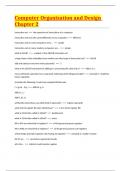Computer Organization and Design
Chapter 2
instruction set >>> the repertoire of instructions of a computer
instruction sets are (the same/different) across computers >>> different
instruction sets in early computers were... >>> simple
instruction sets in many modern computers are... >>> simple
what is LEGv8? >>> a subset of the ARMv8 instruction set
a large share of the embedded core market uses what type of instruction set? >>> LEGv8
add and subtract have how many operands? >>> 3
what is the LEGv8 instruction for adding b+c and saving the value into a? >>> ADD a, b, c
every arithmetic operation has 3 operands, following which design principle? >>> principle 1: simplicity
favors regularity
translate the following C code into compiled LEGv8 code:
f = (g+h) - (i+j) >>> ADD t0, g, h
ADD t1, i, j
ADD f, t0, t1
arithmetic instructions use which kind of operands? >>> register operands
what kind of register file does LEGv8 have? >>> a 32 x 64 bit register file
what is 64 bit data called in LEGv8? >>> doubleword
what is 32 bit data called in LEGv8? >>> word
X0 to X30 are what kind of registers? >>> 64-bit general purpose registers
X0 to W30 are what kind of registers? >>> 32-bit general purpose sub-registers
which design principle supports only having 32 registers? >>> principle 2: smaller is faster
X0-X7 are... >>> procedure arguments/results
x8 is the... >>> indirect result location register
,X9-X15 are... >>> temporaries
X16-X17 (IP0-IP1) may be... >>> used by linker as a scratch register, other times as temporary register
X18 >>> platform register for platform independent code; otherwise a temporary register
X19-X27 >>> saved
X28 is the... >>> stack pointer
what does SP stand for? >>> stack pointer
what does FP stand for? >>> frame pointer
X29 is the >>> frame pointer
X30 is the >>> link register (return address)
what does LR stand for? >>> link register
XZR or X31 is... >>> the constant value 0
using register operands, what is the following C code compiled in LEGv8 code?
f = (g+h) - (i+j)
(where f..., j are in X19, X20..., X23) >>> ADD X9, X20, X21
ADD X10, X22, X23
SUB X19, X9, X10
the main memory is used for which type of data? >>> composite data
what are 3 examples of composite data? >>> arrays, structures, dynamic data
what are the 2 steps to apply arithmetic operations to data in memory? >>> load values from memory
into registers, store result from register to memory
how is memory addressed? >>> in bytes
each address in memory identifies an... >>> 8-bit byte
LEGv8 (does/does not) require words to be aligned in memory >>> does not (except for instructions
and the stack)
, what is the compiled LEGv8 code of this C code?
A[12] = h + A[8]
(where h is in X21, and the address of A is in X22) >>> LDUR X9,[X22,#64]
ADD X9,X21,X9
STUR X9,[X22,#96]
assuming you want to load the value in the array A at index 8, what should you pass to the LEGv8 LDUR
instruction?
(assume the address of A is X22, and you are loading into X9) >>> X9, [X22, #64] (an index of 8 requires
an offset of 64)
which are faster to access, registers or memory? >>> registers
operating on memory data requires... >>> loads and stores
using loads and stores means (more/less) instructions are executed >>> more
when must the compiler use registers for variables? >>> as much as possible
when does the compiler use memory for variables? >>> only when the variables are less frequently
used
ADDI represents what kind of instruction? >>> addition with a constant (or "immediate")
constant/immediate operands are supported by which design principle? >>> principle 3: make the
common case fast
the range of an unsigned int using 32 bits >>> 0 to 4,294,967,295 (2^n -1)
the range of a signed int using 32 bits >>> -2,147,483,648 to 2,147,483,647 (-2^(n-1) to 2^(n-1) -1)
which bit is the "sign" bit? >>> bit 31
in 2s complement, does 1 or 0 represent negative? >>> 1
in 2s complement, does 1 or 0 represent positive? >>> 0




